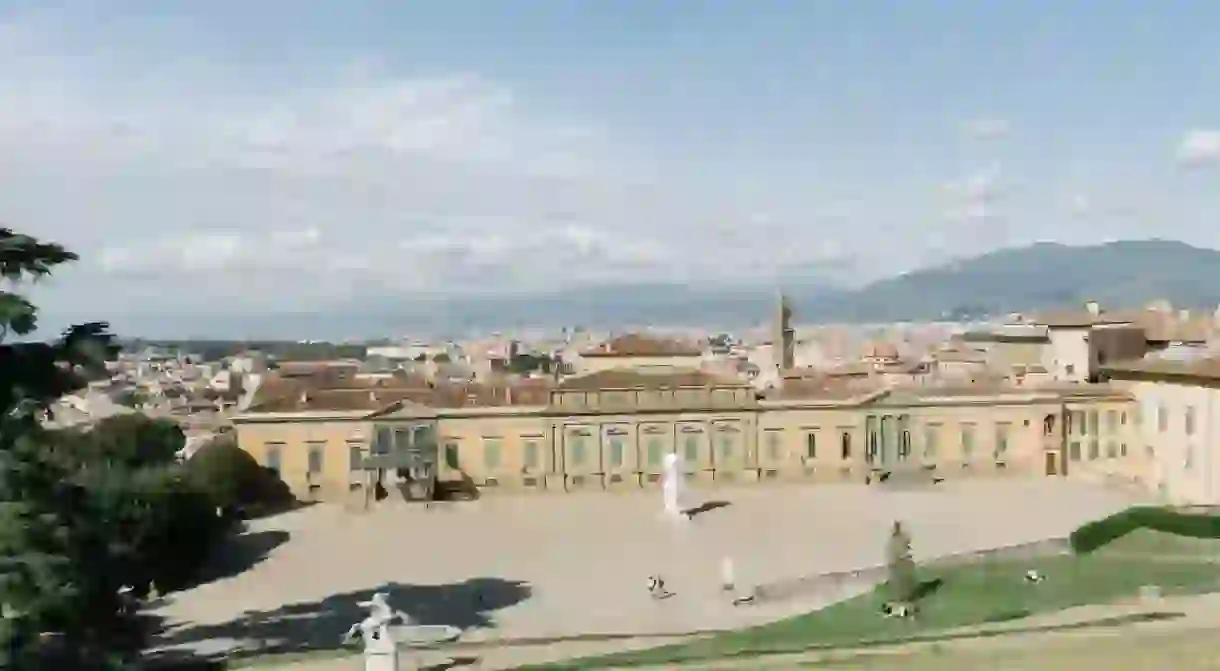In Florence, Artistry and Craftsmanship Are the Lifeblood of the City

The stone-paved streets of Florence have been worn down throughout the centuries by a myriad of craftsmen and artists, working with leather, paint, silk and gold. The picturesque Italian city has also made its mark on fashion history as the home of Gucci – and its venerable design influence is still felt today.

In Piazza della Signoria, in the centre of Florence, stands the historic Palazzo della Mercanzia. Built in 1359, it was once home to the court responsible for resolving disputes between members of Florence’s many art guilds. Today, the beautiful stone building neatly encompasses how the past and present coexist in Florence – it now houses lauded fashion brand Gucci, which is paying homage to its Florentine roots with store and exhibition space Gucci Garden, which is also home to the Michelin-star Gucci Osteria da Massimo Bottura. It’s one of many brands to have sprung from the creative city, where the craft trade is still flourishing.

“In Florence, there are still many artisans practicing the trades that are generations old,” says art historian and author Laura Morelli. “You can visit leather workers stamping gilded details into belts and wallets; women weaving fabrics on 300-year-old looms; goldsmiths using the tools of their great-grandparents. Also, one of the most wonderful things about Florence is that you can find a craftsperson to make just about anything your heart desires, from custom shoes and suits to stationery, books, clothing and furniture.”

Florence’s ascension to the top of the art, craft and fashion industries started in the 12th century when its craft guilds, the Corporazioni di Arte e Mestieri, dominated the city’s economic and social organisation. “The seven major guilds (the arti maggiori), five middle guilds (arti mediane) and nine minor guilds (arti minori) organised the lives of all craftspeople,” Morelli explains. “Every neighbourhood of Florence pulsed with the lifeblood of these trades – the making of everything from hats to belts, keys, goblets, rugs, spoons, shoes and stockings. Each craftsperson had a role to play in Florentine society, and each contributed to the city’s culture of high technical skill, reputation for quality and economic power.”

The Tuscan international leather fashion industry is one of the trades that began flourishing in the 1300s, when the city had some 1,500 shoemakers. As well as making shoes for locals, the cobblers took part in the export trade and formed the roots of Tuscany’s leather industry. Some 600 years later, their skills would indirectly lead to the birth of the Gucci fashion house. Guccio Gucci was the son of a leather artisan and left Italy for London, where he worked at the Savoy Hotel; one of his jobs there was to carry visitors’ luggage.

“Gucci returned home to Florence in 1921 and refocused his family on designing fine leather luggage and accessories for a wealthy international clientele,” Morelli says. “He soon brought the leather goods of his native city to international fame as one of the most recognised names in the fashion world.” The brand has moved on from its functional beginnings, when it made leather saddles and accessories (a history that’s acknowledged in the gold horse-bit detailing on many of its pieces today) to become an international fashion giant.
The curator of Gucci Garden, Maria Luisa Frisa, explains that the brand is still closely connected to Florence. “It’s an international brand that gets its power from the quality of the work that craftspeople in this area do and the way items are made here,” she says.

The brand’s Florentine heritage still plays into its identity – for its spring/summer 2018 collection, Gucci collaborated with artist Ignasi Monreal to create an ad campaign that nodded to its hometown, which is known as the birthplace of the Renaissance, as classic Renaissance paintings were reimagined to showcase the brand’s new collection. In 2017, it announced a multifaceted cultural project with the Uffizi Gallery and the city of Florence, which saw the brand contribute to the restoration of the 16th-century Boboli Gardens. And Gucci Garden’s social spaces also let the brand interact with Florence today. “Conversations about contemporary publishing alternate with films in the Cinema da Camera (a small theatre for experimental film in the Galleria space),” explains Frisa, “and it also works with festivals and other institutions around the city. It’s a place that’s in sync with the present but still references a rich and extraordinary past.”

As well as working at Gucci Garden, Frisa curated the book Firenze Fashion Atlas, which focuses on the city’s relationship with fashion. Her favourite artisan and fashion shops in the city, she says, are “Officina Profumo-Farmaceutica di Santa Maria Novella, handcrafted footwear store Mondo Albion and the showroom for knitwear collections from the designer Boboutic.”
For special, handmade items, Morelli suggests checking out Florence’s Oltrarno neighbourhood. “Today,” she says, “many makers of traditional wares still cluster in the Oltrarno section of town, especially around the Piazza Pitti and the Borgo San Frediano. This wonderful section of town preserves the character of an Old World artisan neighbourhood.”














